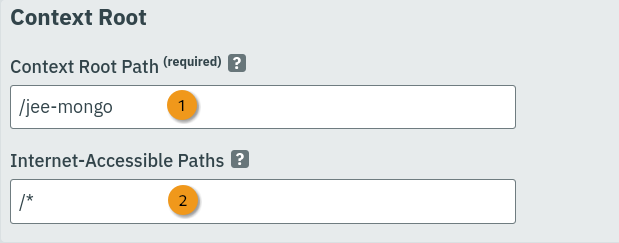Context Root
The context root configuration of an application determines the path at which the application is accessible relative to its Namespace when deployed.
The Context Root configuration can be found on the main configuration page.
-
❶ The Context Root: This is the endpoint on which your running application can be accessed. It is relative to the Namespace domain name.
-
❷ Internet Accessible Paths: This can be used to restrict which sub-paths of your application’s context root can be accessed over the internet.
Context Root
Define the application’s accessibility path within the namespace’s domain by entering a path segment starting with "/". This path becomes the context path for the deployed application.
Internal Access: By default, the application can be accessed by other applications within the same namespace using the URL http://applicationName/contextRoot/.
Example
Root Domain Access: If your application is the primary one in the namespace, and you want it to handle requests at the domain root, use the value /. In that case, the application will be accessible directly on the namespace domain https://namespace-domain.payara.app Subpath Access: For the application to respond to requests at a specific subpath, like https://namespace-domain.payara.app/api/, set the value to /api. This makes your application accessible at that subpath within the domain.
Internet Accessible Paths
To ensure controlled access to various parts of your application, you can specify which sub-paths of your application’s context root are open to the internet and which remain private within your namespace.
Here’s how to manage access:
Publicly Accessible Sub-Paths: Use space-separated patterns, formatted as /prefix*, to designate sub-paths that should be accessible from the internet. Only the sub-paths that match these specified patterns will be accessible via your namespace’s domain name. Internally Accessible Paths: Sub-paths not matching the specified patterns will remain accessible only to applications within the same namespace, ensuring internal communication or functionalities remain private.
Example
Assuming your application has a context root of /orders, and you’ve designated /details/* and /cancel/* as internet-accessible paths. In this case, URLs such as https://namespace-domain.payara.app/orders/details/000234 or https://namespace-domain.payara.app/orders/cancel/00234 will be routed to your application, making these services available to users over the internet.
Conversely, a request to https://namespace-domain.payara.app/orders/place will be directed to the application that manages the root namespace because /place is not listed as an internet-accessible path.
For internal access, other applications within the namespace can reach the /place handler of this application through http://applicationName/orders/place, allowing for secure, namespace-contained communication between applications.
